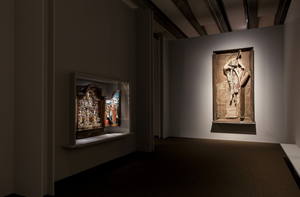
Museum Hof van Busleyden is presenting monumental work by Berlinde De Bruyckere (1964, Ghent). The world-famous Belgian artist engages in a dialogue with the museum’s masterpieces, the newly restored ‘Enclosed Gardens’, which have recently begun to attract considerable interest once again. The contemporary artist De Bruyckere first encountered the magical ‘Enclosed Gardens’ from Mechelen in 2016.
Image: It Almost Seemed a Lily photo by Hof Van Busleyden
Museum Hof van Busleyden is presenting monumental work by Berlinde De Bruyckere (1964, Ghent). The world-famous Belgian artist engages in a dialogue with the museum’s masterpieces, the newly restored ‘Enclosed Gardens’, which have recently begun to attract considerable interest once again. The contemporary artist De Bruyckere first encountered the magical ‘Enclosed Gardens’ from Mechelen in 2016. She was immediately gripped by the fragility and beauty of these sixteenth-century retable cases. The exhibition at Museum Hof van Busleyden enables De Bruyckere to set her own work against the little masterpieces, which have been given a permanent home at the museum.
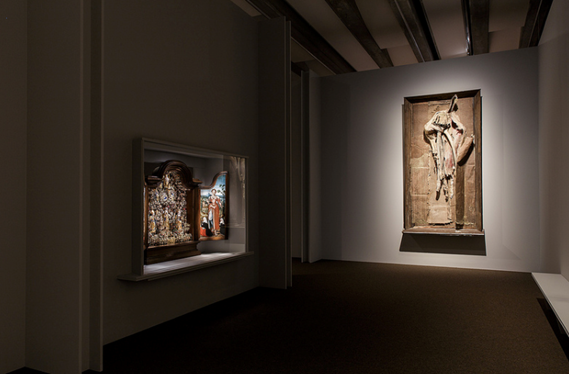
It Almost Seemed a Lily photo by Hof Van Busleyden
Concealing and revealing
‘Every sculpture I have ever made has been determined by reality: scale 1:1. The sculptures with horses, the human figures, the trees, the deer: none of them ever deviated much from the moulded original. This time it was different. I was unable to translate my fascination for the excessive array of flowers and lilies in the Enclosed Gardens on a 1:1 scale. The size of an actual lily was inadequate to express its splendour and complexity. The Enclosed Gardens’ minuscule lilies exploded in my mind and prompted a substantial shift in terms of scale. I gave up on the search for large-scale leaves in the Botanical Garden very quickly: they lacked the power and structure I was looking for. I had no choice but to make the “stamens” and the “petals” myself.’
Berlinde De Bruyckere
The series It Almost Seemed a Lily consists of monumental wooden frames containing a single silhouette: that of a flower resembling a peony or a lily. Disproportionately large and imposing, yet at once vulnerable and fragile. The frames are constructed from eighteenth-century oak floorboards, iron, weathered and frayed blankets, wallpaper and a semi-transparent layer of wax built up in different colours. These materials overlap, cover and reveal an amorphous form, in which the attentive viewer makes out flower, stamen and pistil. They allude to De Bruyckere’s other work – the evolution of which is also explored in the exhibition – and are enriched with meanings that refer to the Mechelen ‘Enclosed Gardens’ and the antique myth of Hyacinthus.
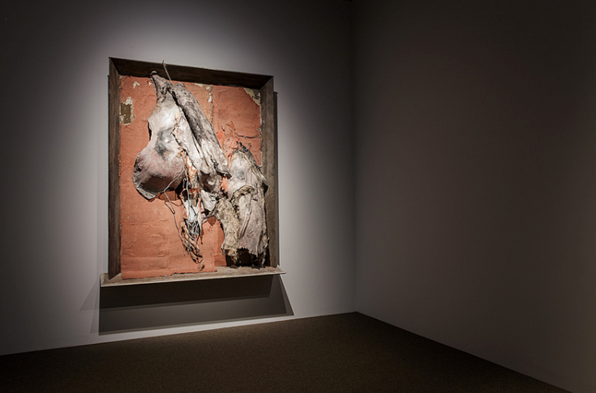
It Almost Seemed a Lily photo by Hof Van Busleyden
Multiplicity and internalization: Mechelen Enclosed Gardens
Oak cases with wings, filled with a mix of artefacts, decorated the rooms of Mechelen’s Augustinian nuns for hundreds of years. They were made in the first half of the sixteenth century, in and around their convent. For these sisters, who cared for the sick and the
elderly and administered the hospital, the little Gardens represented a microcosm of the larger world and formed part of the nuns’ spiritual life.
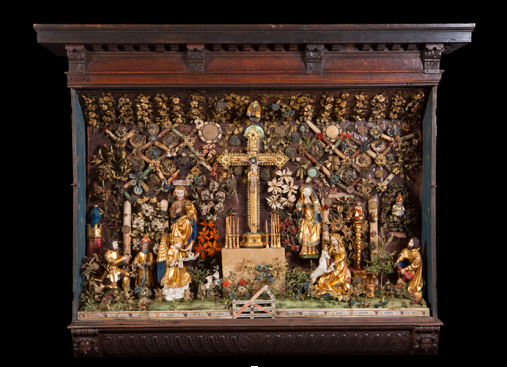
It Almost Seemed a Lily, Mechelen Enclosed Gardens
The seven surviving Mechelen Gardens house anywhere from one to over twenty polychromed figurines or objects carved in walnut and occasionally in alabaster. Relics also feature. The other little objects in the Gardens are creative combinations of everyday materials: copper, tin, papier-maché, parchment, wax, pipe clay, glass, seeds, fruit pits, wood and so forth. Some small artefacts and materials were recycled and given a second life in the Gardens, turning them into ‘memory boxes’.
The use of a wide variety of materials in surprising combinations lends the little Gardens a hybrid and mysterious character. The more they have accumulated layers of history, memory and meaning, the greater their richness. A number of elements, including flowers decorated with beads, might have been made by the nuns themselves, although experienced artisans from the embroiders and braid-makers’ guilds are likely to have played a major role in the complex creation process. Either way, the Gardens are a testimony to both immense craftsmanship and unbridled imagination. Their power to inspire is now also clear.
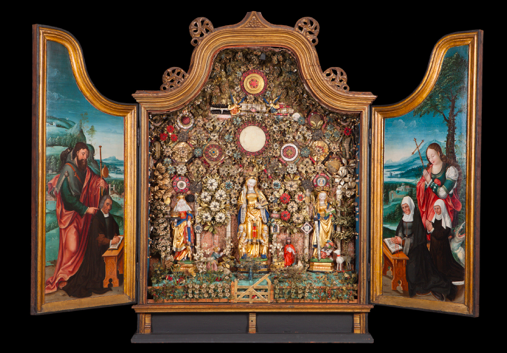
It Almost Seemed a Lily
Impalpable materiality
The art historian Barbara Baert writes in the book accompanying ithe exhibition: ‘The idiosyncratic qualities of both the late medieval Gardens and Berlinde De Bruyckere’s monumental responses raise questions about the classical definitions of the creative processes, the relationship between the artist and his or her work, and about the alleged breakdown between form and material. They force us to turn our artistic expectations and views towards a less polarized and more organic vision of what it means to ‘make’ something, and consequently of the intimate relationship that the artwork maintains with the world and life itself.’
Where do the worlds of It Almost Seemed a Lily and the Enclosed Gardens intersect? The differences would appear substantial: detail versus suggestion; much versus little; highly figurative versus almost abstract; narrative versus associative. And yet... De Bruyckere’s work and the little Gardens both transcend themselves – paradoxical though it sounds – through their materiality.
In essence, the Enclosed Gardens suggest a paradisiacal garden, a utopia. We see more than is actually there in the little stones and relics wrapped in fragments of textile, in the abundance, the many stimuli, the stories and the references that the Gardens evoke. Their rich material variety sets your imagination working, transports you to another place and time. They refer to ‘something’ essential beyond themselves. Through their materiality.
The same materiality is an essential part of Berlinde De Bruyckere’s work. It fascinates her: piles of blankets she allows to weather in her garden; the stiff hairs in the casts of animal skins; dead branches in a forest. Materials frequently have ambiguous meanings for her: blankets that protect and suffocate; lead roses that entice and poison; flowers that testify to blossom and decay. Fatal beauty. Profound contradictions that people sense and which exist in symbiosis. De Bruyckere’s materiality refers to fundamental human experiences: vulnerability and strength, efflorescence and decay, worship and eroticism.
Sigrid Bosmans, artistic director of Museum Hof van Busleyden : ‘The contemporary monumental sculptures by Berlinde De Bruyckere, an classical story and the 400-year-old Enclosed Gardens from the Museum Hof van Busleyden connect with each other, change each other, transcend time and place and create a bigger picture. The exhibition It almost seemed a lily is like an uncontrollable dialogue that reveals new meanings. This process of unraveling, isolation, fragmentation and reconnection matches the character of Museum Hof van Busleyden perfectly.’
The Enclosed Gardens restored
For four years, the Enclosed Gardens were teased apart, studied, documented, photographed and conserved with a view to the reopening of Museum Hof van Busleyden in 2018. A team of ten conservators was joined by other experts to oversee the operation. Never before has so much information been gathered on Mechelen Enclosed Gardens.
The restorer Lieve Watteeuw writes in the book accompanying the exhibition: ‘The cool space is completely silent. When I carefully open the shutters, the creak of the hinges is barely audible. The sequins quiver with the slightest movement of air, like twinkling dewdrops. The Garden is half empty, and the tinfoil-backed paper is fissured and torn; it is slowly beginning to flake. Through the cracks, the centuries-old oak is visible. The layers of memory have left traces on the bare wood; history is unfolding. An Agnus Dei fashioned from fragile beeswax is suspended from a brass disc with several loops of fine metal wire. Flowers in pale silk twist out from the walls, the parchment is dull, the silk broken. As we identify and unravel the memories in the Gardens, the process of figuring out the story of the cabinet and its contents has been taxing our eyes and our brains for some months now.
‘The cold metal of the tweezers taps against the fine bamboo paintbrushes. Centuries-old dust swirls down with each gentle touch. The haze of time that coats the Gardens is slowly removed. We are getting closer to the creation, the beginning. The layers of dust that accumulated on the cabinets over the centuries, when they were stored in the nuns’ chambers, are captured in a tiny plastic container.’
Anouk Stulens, managing director of Museum Hof van Busleyden: ‘The conservation- restoration project of the Enclosed Gardens was a unique and successful cooperation between different research institutions, scientists and an interdisciplinary team of restorers, in collaboration with the museum. The extended monograph on this subject contains the collected research results and accumulated knowledge. The publication of this important academic work strengthens the museum’s core task and supports its basic functions.’
Ovid’s Metamorphoses: De Bruyckere’s ‘Bible’
It almost seemed a lily: the words used in his Metamorphoses by the Roman poet Ovid – whose 2000th anniversary we commemorate this year – to describe the purple-coloured flower into which Hyacinthus is transformed on his tragic death, struck in the head by a discus thrown by Apollo. The god was in love with the handsome youth, yet snuffed out Hyacinthus’ life.
Berlinde De Bruyckere views Metamorphoses as one of her ‘Bibles’. The transformation of people into animals, stones, plants and flowers – an essential element of her work – is Ovid’s handhold too in a tumble of stories that explore the great themes of human life. Here too, old tales are replete with symbolism and continue to resonate.
The contemporary, monumental sculptures of Berlinde De Bruyckere, a tale from antiquity and the sixteenth-century Mechelen Enclosed Gardens from Museum Hof van Busleyden intertwine, transform one another and are subsumed into a greater whole, transcending time and place. The exhibition It Almost Seemed a Lily is like an uncontrollable dialogue that constantly reveals fresh meanings. This process of unravelling, isolating, fragmenting and reconnecting fits in perfectly with the specific character of Museum Hof van Busleyden.
Housed in the Renaissance city palace of the humanist Hieronymus van Busleyden, the museum is the ideal place in which to inscribe a new future on the past. With the spirit of the sixteenth-century building as its starting point, it aims once more to become a location that unites art and culture – a hotbed of new ideas and an engine to drive the city’s dynamism. This is a place for a new humanism that interacts with the past and, in so doing, not only explores the actuality of that past, but also visualizes or interrogates the future. We’re not doing all this on our own, but with lots of partners. So the dialogue does not express just one perspective or logic, but many.
It Almost Seemed a Lily
Berlinde De Bruyckere at Museum Hof van Busleyden
Until 12 May 2019

ArtDependence Magazine is an international magazine covering all spheres of contemporary art, as well as modern and classical art.
ArtDependence features the latest art news, highlighting interviews with today’s most influential artists, galleries, curators, collectors, fair directors and individuals at the axis of the arts.
The magazine also covers series of articles and reviews on critical art events, new publications and other foremost happenings in the art world.
If you would like to submit events or editorial content to ArtDependence Magazine, please feel free to reach the magazine via the contact page.